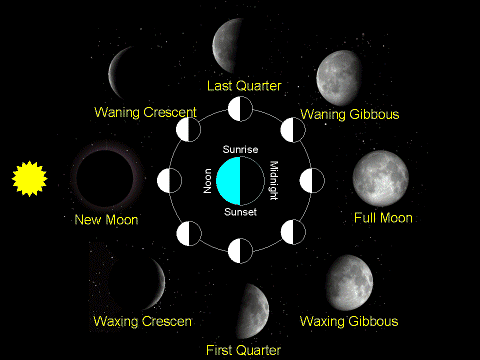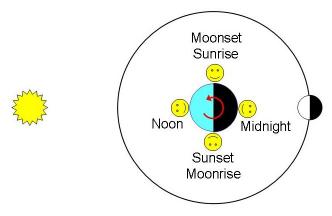Motions in the Heavens
Key Ideas: What is seen with the eye?
Daily Motions
- Reflection of the Earth's Daily Rotation
Annual Motions
- Reflection of the Earth's Orbital Motion
- Ecliptic: The Path of the Sun
Bodies: The Sun, The Moon and its phases, The planets ("Wandering stars" that follow complex paths
and retrograde motion near the Ecliptic.)
The Starry Night
From a dark site, about 6000 stars are visible to the naked eye on a
moonless night.
This represents only a tiny fraction of the nearly 200 Billion stars
that make up the Milky Way Galaxy in which we reside.
Constellations
From time immemorial, people have seen patterns and drawn figures in the
sky by connecting the bright stars.
These starry figures are the Constellations
All peoples have populated the night sky with constellations.
Figures in the Sky
Most constellations are composed of bright stars that stand out from the
others.
Many look like what they are named
Peoples greatly separated in distance and/or time often made the same
connections. A few common examples:
- Orion depicted as a male human
- Scorpius called a scorpion by most desert peoples
- Celestial Rivers and Snakes
[Look for Orion in the winter sky, it rises in the east/southeast around sunset
beginning in late December].
The Classical Constellations
The oldest known constellations (Leo, Taurus, Scorpius) appear in
cuneiform tables dating from 3000 BC, but may be older still.
The Greek constellations and associated star lore were described in
the Phaenomena of Eudoxus of Cnidos (c. 366 BC), and likely
derived from Babylonian (Assyrian?) lore of c. 1100 BC.
The Greek astronomer Ptolemy made a catalog of 48 "classical"
constellations in the 2nd century AD:
All of the classical constellations are those visible from the middle
latitudes of the northern hemisphere.
Stars are not fixed!
They move in the sky over long periods of time. In 20,000 years the Big Dipper will look noticably different than it does today. Why? The stars of our galaxy orbit in a plane, or sheet, in a plate-like disk geometry, and all orbit around the galaxy at roughly the same speed. But, just like care on the highway, they have motions relative to one another. They thus appear to move in the sky.
Daily Motions
Objects in the sky appear to rise in the East and set in the West each
day. This apparent daily motion is a reflection of the Earth's rotation
about its axis.
- Earth rotates once a day (24 hours)
- The sense of rotation is Eastward
- Facing North, rotation is towards the Right.
The Sun-Earth orbital plane is called the ecliptic plane. This is the plane that we see the Sun move in. This is the path of the Sun from our perspective.
Annual Motion of the Sun
Over the course of a year, the Sun appears to move a little towards the
East each day as seen with respect to the background stars . This daily
eastward drift is about 1° per day (there are 365 days in a year, but
360° in a circle).
This apparent motion is a reflection of the Earth's annual orbit
around the Sun. The fixed stars (at least on human timescales) apparently don't move. Over the course of the year we could look to see which stars are up in the east just before sunrise. We would find that over the course of the year the Sun's position on the sky with respect to those background stars changes. This is because, as we orbit around the Sun, our perspective on the Sun changes with respect to those background stars.
Our Nearest Celestial Neighbor
The Moon is a natural satellite of the Earth.
Its orbit around the Earth is elliptical:
- ~0.15% out of circular.
- Tilted by 5º from the Ecliptic.
- Mean Distance: 384,400 km
- Perigee (Closest Approach): 363,300 km
- Apogee (Maximum Distance): 405,500 km
- Appears ~11% larger at Perigee than at Apogee
Synchronous Rotation
The Moon's rotation period is equal to its orbital period:
- The Moon completes 1 rotation about its axis in the same time as
it completes 1 orbit around the Earth.
As a consequence, the Moon always keeps the same face towards the
Earth.
- Near Side: hemisphere facing towards the Earth
- Far Side: hemisphere facing away from the Earth
The synchronization of the Moon's rotation and orbit is caused by
strong tidal forces from the Earth that effectively "locks" the
Moon's orientation relative to the Earth.
[Note: The degree of synchronization is not perfect for two reasons.
First, the Moon's orbit is elliptical rather than circular, so that the
Moon's orbital speed is faster at perigee and slower at apogee. This
mis-match in the exact orbital and rotation rates results in an apparent
east-west "rocking" motion of the Moon by about 7.9 degress over the
course of a month. The second is that the axis of the moon's rotation
is tilted by about 7 degrees relative to its orbital plane (like the
Earth's 23.5 degrees). This leads to an additional north-south nodding
motion over the course of a month. The combined rocking and nodding
motion motion is called "libration". You can see libration in the lunation movie below.]
Phases of the Moon
The Moon produces no visible light of its own
- It shines only by reflected sunlight
- Surface is very dark, only ~7% reflective
During the month, we see a complete cycle of Phases:
- The sunward hemisphere is fully lit.
- The opposite hemisphere is dark.
The phase of the Moon depends on the fraction of the sunlit
hemisphere visible to us.

- Graphical depiction of the phases (click to see full-size)
(Graphic by R. Pogge)
[Lunation
Movie (Graphic by R. Pogge). This movie shows one month of lunar phases. Note how the
moon appears larger at perigee and smaller at apogee. Also note the
apparent nodding and rocking motions due to "librations" as mentioned
above.]
New Moon & Full Moon
New Moon:
- Moon and Sun are on the same side of the sky.
- Near side is in total darkness.
- Moon and Sun rise together.
Full Moon:
- Moon is opposite the Sun in the sky.
- The near side is fully illuminated.
- Moon rises as the Sun is setting.
Quarter Moon
Quarter Moons occur when the Earth, Moon, & Sun are at right
angles:
- Half of the near side is illuminated
- Half of the far side is illuminated
First Quarter:
- Quarter Moon between New Moon and Full Moon.
Last Quarter:
- Quarter Moon between Full Moon and New Moon.
- Sometimes also called "Third Quarter"
With New Moon and Full Moon, they help to divide the Lunar Month into
quarters.
Waxing & Waning
Waxing: increasing illumination
- Waxing Crescent: just after New Moon
- Waxing Gibbous: just before Full Moon
Waning: decreasing illumination
- Waning Gibbous: just after Full Moon
- Waning Crescent: just before New Moon
Moonrise, Moonset...
You don't see all moon phases at all times
- Never see a crescent moon at midnight.
- Never see the last quarter moon at sunset.
- Never see a full moon during the day.
Times of rising and setting depend on the details of the Earth-Sun-Moon
configuration as viewed from the surface of the rotating Earth.
Moonrise and Moonset during Full Moon:

(Click on the image to view at full scale [Size: 28Kb])
- Full Moon rises as the Sun sets.
- The Full Moon is in mid-sky at Midnight.
- Full Moon sets as the Sun rises.
- Full Moon cannot be seen during the day.
Other examples were given in class (Better, work out the approximate
moonrise and moonset times for the current phase of the Moon, and then
go outside and see if your predictions are correct!)
The View from the Moon
Question: What would an astronaut on the Lunar near side see
during one month?
Answer:
- See the Earth neither rise nor set, but stay nearly fixed
at the same position in the sky.
- See the Earth rotate on its axis once every 24h.
- See the Earth go through phases.
The Naked-Eye Sky
Celestial objects visible to the naked-eye include
- Sun:
- Bright disk ~1/2° across
- Moon:
- Pale disk ~1/2° across that goes through monthly phases.
- Stars:
- Pinpoints of light that appear fixed relative to each
other on the Celestial Sphere.
- Planets: (Greek: planetai = "wanderers")
- Points of light that move relative to the "fixed" stars.
- Stay within a few degrees of the Ecliptic
- Follow complex paths that take between 88 days
(Mercury) and 30 years (Saturn) to complete a
circuit across the sky.
Five Classical (those that can be seen with the naked eye) Planets:
- Mercury, Venus, Mars, Jupiter, & Saturn
Inferior & Superior Planets
Early astronomers recognized that the 5 classical planets could be
divided into two groups:
Inferior Planets: Mercury & Venus
- Appear to follow the Sun across the sky.
- <28° for Mercury, and <47° for Venus.
Superior Planets: Mars, Jupiter, & Saturn
- All move along the Ecliptic on paths seemingly
independent of the motions of the Sun.
- All can appear in the sky any time (e.g., around midnight)
Retrograde Motion
In general, the planets move eastward relative to the
"fixed" stars.
- Called "Direct Motion".
- Motion is non-uniform (not at the same speed).
Sometimes, however, the planets appear to
- Slow down & stop!
- Start moving westward, or RETROGRADE,
- Slow down & stop again,
- Resume moving eastward again.
[Click Here to see an image (16Kb) of the
retrograde motions of Mars during 1994/95 when it made a particularly
characteristic loop. A 688Kb QuickTime movie
shows this figure in motion (beware! it is a large file)]
(Graphic by R. Pogge)
Apparent retrograde motion is observed in all planets.
In all cases the apparent paths followed by the planets as seen from
the Earth are very complex. They make various loops and S-curves during
their retrograde motions that are due to the tilts of their paths
relative to the Ecliptic.
[Click Here to see an montage (18Kb)
of the recent (1998-2000) retrograde motions of Mercury, Venus, Mars,
Jupiter, and Saturn. Note that Jupiter & Saturn, currently visible
after sunset high in the Eastern sky, are just now (Jan 18) ending a
period of retrograde motion that started back in October of last
year.](Graphic by R. Pogge)
Here is a composite picture of Mars undergoing retrograde motion from APOD.
Here is a movie showing retrograde motion for Jupiter and Saturn
Unlike all of the other motions we've seen thus far, planetary
motions are dauntingly complex.
The struggle to understand these motions took nearly 3000 years.
A Question of Approach
How do we explain the motions of the planets?
Two approaches have been taken:
Phenomenological Description
- Find a way to compute the motions without worrying about the
details of why they work this way.
- Goal is to "preserve appearances" (i.e., make reliable predictions)
Physical Description
- Discover the underlying physical principles behind
the planetary motions (i.e., ask "why" they move).
- Predictions of the motions should then follow from first principles
Updated: 2014 August, Todd A. Thompson
Copyright © Richard W. Pogge, All Rights
Reserved.


